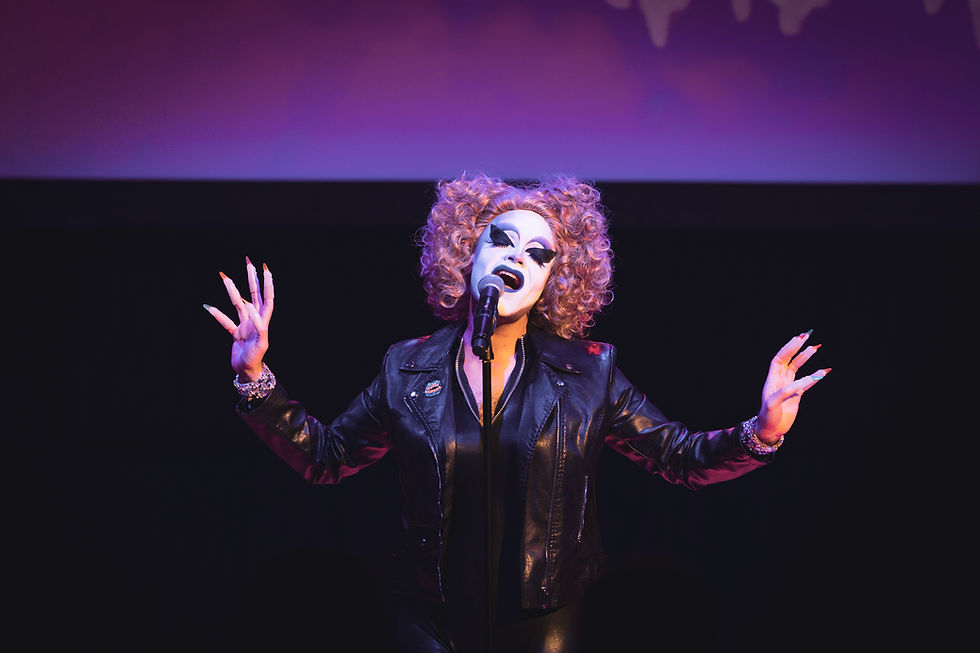- Vanessa Marenco
- Aug 21, 2021
- 4 min read
Updated: Sep 1, 2023
If, like the rest of us, you were mired in the hardship and confusion of 2020 and are currently contending with the re-emergence of a time-warped, slightly pudgier version of yourself in 2021, you may have missed Dartmouth’s In the Spirit series. Indigenous Performance Productions partnered and co-produced with Beatrice Thomas and Kyle DeVries of Authentic Arts and Media to bring you the In the Spirit series; six installments of performance art by Native, Queer and Two-Spirit artists over the course of nine months. This series served as a space to re-center and to ground oneself amidst the chaos. Featuring artists such as Landa Lakes, Storme Webber, Snowflake Calvert, DeLesslin George-Warren and many more. Not only did In the Spirit strive to bring audiences moving and insightful performances from these storytellers, dancers, drag artists and poets, but it offered us conversation and context from the artists themselves, allowing us to watch and interact as they examined their Native, Queer and Two-Spirit heritages through performance and dialogue.
In keeping with our newly mangled and disjointed sense of time you may be surprised to find we are only a few months out from the anniversary of the series premier. And as our languid pace quickens and we find ourselves fully immersed in a summer no less confusing or uncharted than our last, it may do us well to take another look at In the Spirit, and remind ourselves that we can always come back to the stories, for grounding and for fun.
The series begins with an artist roundtable hosted by the dynamic and enchanting Creative Producer, Black Benatar and features discussion with artists Geo Neptune, Anthony Hudson/Carla Rossi, and Tony Enos. The roundtable discussion provides viewers with insight, humor and history into their performances. Thanks to their candor and context we are able to understand the vision and purpose of the talents we are going to witness in the next several installments of the series.

The first performance is given by culture bearer Landa Lakes (Chickasaw), (pictured to the left), who gifts us with an “Aunty TedTalk” that weaves viewers through Traditional stories passed down for generations, as well as personal stories and lessons she has come away with. However, the true unraveling of it all is visually saved for the very end in a mesmerizing song rendition that Landa performs beautifully. Snowflake Calvert (Yaqui, Raramuri and Tzotzil Mayan heritage) is a Two-Spirit artist who graces us with a performance both contemporary and Traditional, moving and show stopping, that mixes dance and drag to create a path to healing. She collaborates with interdisciplinary artist Europa Grace and exceeds all expectations and offers viewers a new perspective on body work and how choreography and movement can strengthen our ancestral ties and future endeavors.

The beloved Storme Webber, (pictured to the right) a Two-Spirit artist, curator, writer, and performer uses ‘jazz/poetics’ (Laiwan) to disrupt any preconceived notions brought by the audience and uses spoken word and acappella to tell the story of a young girl venturing into the world and navigating her way through with the help and knowledge given to her by her grandmother. Weaving a tale that highlights empowerment and adventure, and that rejects a trauma narrative, Storme brings the audience a much needed reprieve from the rigidity of colonial constructs we find ourselves mired in daily.

Finally, join DeLesslin George-Warren or “Roo as in kangaroo”, (pictured to the left), a queer artist, activist, and educator from Catawba Indian Nation, for the premiere of his new work about the past, present and future of Catawba Nation. Roo begins with footage of legal proceedings surrounding the MMIWG task force that illustrates precisely how the unyielding barriers and disrespect are woven seamlessly into colonial institutions when Indigenous voices attempt to bring truth and knowledge into the forum. Oscillating between lecture and song, Roo gives us five movements — "įhehęʰ," "hinu," "suksi," "warisare" and "manu." Through this piece we regain a sense of hope and understanding in the perseverance and resilience of the artist as an individual, the Catawba Nation, and Indigneous peoples everywhere.
In the Spirit concludes with another roundtable discussion hosted by series’ producer Andre Bouchard with artists Storme Webber, Landa Lakes, DeLesslin George-Warren and Snowflake Calvert. They tackle big ideas about Indigenous activism, acknowledging the land, and decolonization of art forms, then the artists reflect on their artistic and personal journeys. They discuss the challenges of working within pandemic restrictions, performing to a screen instead of a live audience, and the importance of feeling those connections so many of us are currently missing.
This series is an invaluable resource for all Queer, Indigenous, Two-Spirit peoples and allies. We would like to thank all those who participated and worked to bring this project to life and we hope you will return to the series again and again. Though we may be grappling for a sense normalcy and familiarity, it is crucial to remember that we were and are always striving for change, and that the performances these artists bring us allow us to re-enter the world with intention toward healing and without heightened risk of repeating the mistakes of the past; in the words of Landa Lakes “transformation is vital.”



